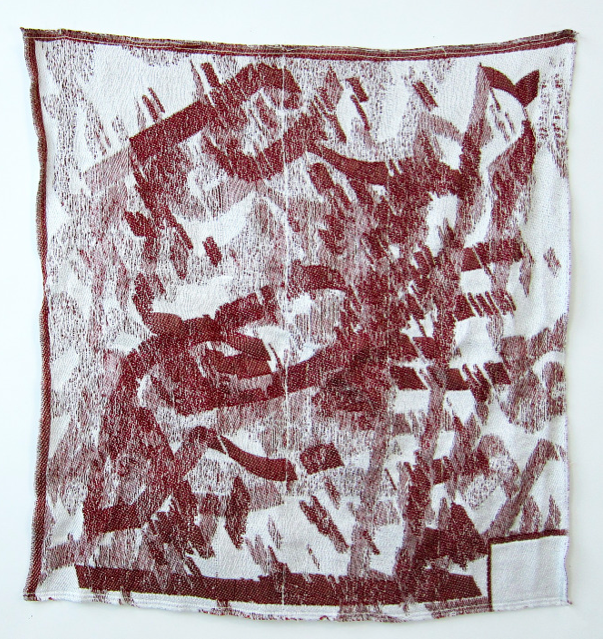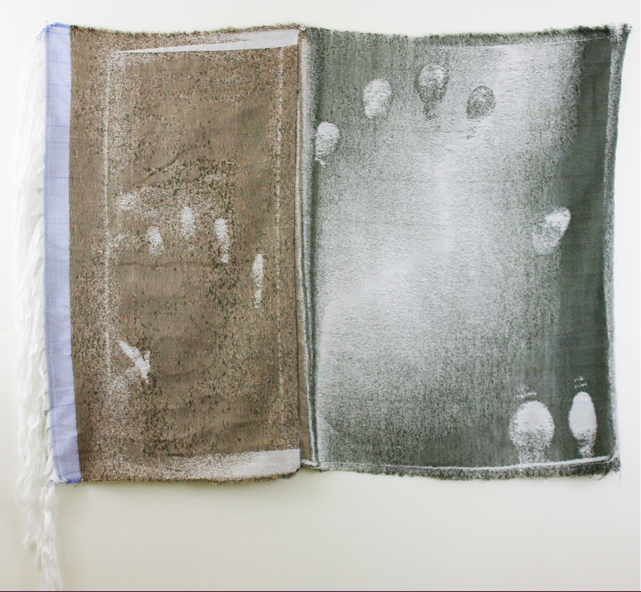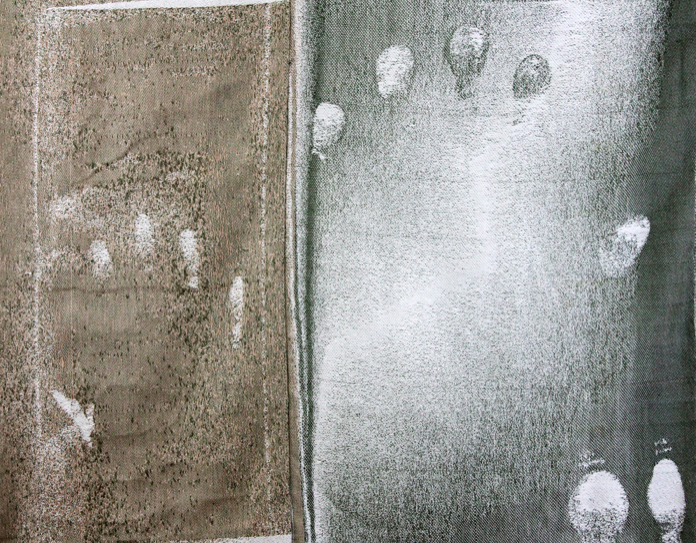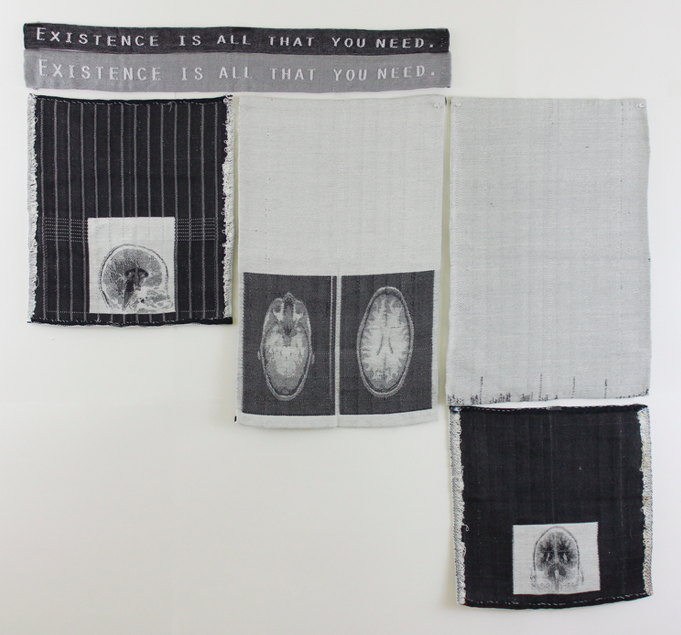Featured Artist Interview: Michelle Ralph-Forton
Michelle Ralph-Forton's work caught our eye when I noticed her intricate jacquard weaving, with understated and visceral stories behind them. She is a graduate of the School of the Art Institute of Chicago, with a Bachelor of Fine Arts. In this interview, Michelle thoroughly describes the process behind the intimate narratives behind her work, and her process with jacquard weaving.

PB: What is a background on your jacquard works and your work overall? What are you inspired by?
M: Location, sound, memories, contradictions, simultaneous thoughts, and abstractions are all predominant themes in my work. Thisis either from the initial steps and concept, to the process, or end result. I am affected by the space around me, and analyze how I interact with the environment and its striking characteristics. Undoubtedly, this plays a key role in what I create. I tend to capture inspiration based on a specific time, place, and thought and may or may not translate this with past experiences. In this sense, time is always relevant, either subtly or not. Although I do not classify myself as a traditional storyteller, I use textiles as a tool to deliberate personal narratives. I am greatly influenced by the people, cultures, and cities I’ve been exposed to, and allow myself to extract what I gain into a more personal perspective. Ultimately, my goal is for viewers to feel an extrinsic intensity, guiding them towards their own interpretation and recollected memories.
PB: What is the process behind your jacquard works?
M: Similar to other processes, the first step is to gather sources. Once I have cherry picked which images I’d like to work with, I begin to edit them in Photoshop. This is another neat aspect of jacquard weaving- there are endless directions and possibilities to cross multiple mediums and one of which is when I create these files. You can create collages, scan drawings or photographs, repeat patterns, and basically anything that catches your fancy as long as you have a solid final image! Once I am satisfied, I take the image and make several small test samples. This is where I like to experiment with different threads and materials to use as the weft. I usually like to have structure, so this part opens my eyes to being more spontaneous. I’ve been surprised at some of the unexpected pairings, too, being so different from what I originally imagined. I enjoy seeing this happen.
PB: Is there something specific about the method or aesthetic of jacquard weaving that works well with what you're trying to communicate?
M: Yes! Working on the jacquard strikingly correlates to the way I work and think. I consider myself to be a curious individual, analyzing and subsequently overanalyzing things, including my choice of tools. Artistically, the method of using multiple processes, layering ideas, and being immersed into a repetitive notion for hours is a gateway to convey something with multiple meanings. I have noticed that this is an ingrained part of my persona, as I work best with some sort of organized train of thought. This of course, contradicts my other way of thinking, being to allow and accept things to fall into place organically. There lies a certain power dynamic and mystique when I work with the machine that is alluring and motivates myself to investigate more.
PB: What is the concept behind Blueprint? Does jacquard fit into this? How? (If there is another piece you'd rather talk about - go ahead and replace Blueprint with that piece. Blueprint is gorgeous, but if there is something interesting you want to say about another piece, I would love to hear it! We can always talk about multiple pieces as well.)
M: Blueprint came about as a “happy accident”. I usually carry a journal with me, the pages consist mostly of doodles, sketches, and thoughts. At the time, I was thinking about individualism and the masks we put on either privately or publicly. It’s not a secret that social media has contributed an enormous amount to this false identity we present ourselves to be, and I wanted to capture an idea of entrapment. On one hand, this form of expression can be liberating, as we can try to fix ourselves and exemplify an image to others virtually that cannot be expressed in the same manner with tangible encounters. I am guilty of feeling this and try to analyze why I do feel a difference in my own virtual vs. actual identity. This sense of empowerment and liberation of expression is sometimes expressed most “naturally” through social media than in real life circumstances. It’s a baffling contradiction to think of how social media has morphed our identities in both positive and negative light. Blueprint was my own generic way of expressing that “I exist. I am an individual. This is my identity” without a façade, but instead, a simple fingerprint. Deciding to use the jacquard for this specific work adds the element of ephemerality vs. physicality that all textiles maintain.
PB: What originally brought you to working with fibers and jacquard weaving?
M: I was in transition from the fashion department at SAIC to experiment with the fiber department. I had several teachers recommend that I consider taking textile classes, as a majority of my projects had some form of tactile element incorporated. I started off with screen printing on fabric and was sold immediately. I knew I was in the right place, but I wanted to experiment more. When I enterted a room with rows of looms for the first time I was captivated. When I left I knew I was going to enroll in a weaving course the following semester! Perhaps it was my “old spirit” that was drawn towards this archaic form of art making, but I also contribute my interest to pursue weaving towards my practice of DIY and sustainability. I am particularly found of the handmade, and the thought to create my own textiles, rather than buying and altering fabric, seemed truly special. The next semester I was enrolled in a both a beginners course to floor loom weaving and intro to jacquard weaving. I had no prior knowledge of either, and that semester was a huge challenge. However, it was an interesting dichotomy to take both at the same time, learning what I could create on the floor loom, and how I could expand a similar concept with the technology of the jacquard. In this way, I compared them both simultaneously, and learned their functionalities with this method.
PB: Any tips you would recommend for an artist who's interested in using this medium?
M: Be patient, flexible, expect the unexpected, and never forget to give the jacquard machine lots of TLC! It may sound silly, but this is actually a huge asset to relieve unnecessary frustrations. If you maintain it right, and always check for any loose or broken threads, fix them, and balance the tension, you will most likely not have to stop in the middle of weaving in sheer panic when the machine starts to mishap. When you work with this medium it requires you to act like a technician, giving extra hours to understand the machine and weaving in general. It can be daunting for a beginner, but like everything else, it just requires lots of practice. In my experience, getting to know this machine has been a “Catch-22”. It has become my passion, yet I do not have access to it anymore. Unlike painting or drawing, where supplies are easily accessible, jacquard machines aren’t exactly on the market. They are rare, extremely expensive, and unless one has access to a jacquard outside of an institution, you may be jacquard-less for awhile. This is where I am at right now. I work without my favorite medium, yet I try to incorporate weaving aspects into my current practice. Still, I don’t regret being entranced by this medium one bit!
For more of Michelle Ralph-Forton's work and weavings, visit her website, http://www.michellefaviola.com/












